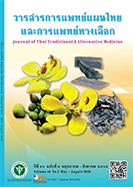ฤทธิ์ต้านเชื้อรากลุ่มเดอร์มาโตไฟต์ของสารสกัดทองพันชั่ง N/A
Main Article Content
บทคัดย่อ
ทองพันชั่ง เป็นสมุนไพรที่ใช้ในทางการแพทย์แผนโบราณของไทยเพื่อการรักษาโรคผิวหนัง และผื่นคัน การทดสอบฤทธิ์ต้านเชื้อราของพืชนี้ พบว่ามีฤทธิ์ดีต่อการต้านเชื้อรากลุ่มเดอร์มาโตไฟต์ซึ่งเป็นสาเหตุหลักของโรคผิวหนังจากเชื้อรา การศึกษานี้มีเป้าหมายเพื่อทดสอบฤทธิ์ต้านเชื้อราของสารสกัดจากส่วนต่าง ๆ ของทองพันชั่ง และวิเคราะห์ปริมาณสารสำคัญที่มีฤทธิ์ต้านเชื้อราของสารสกัดแต่ละชนิดเพื่อพัฒนาวิธีสกัดที่ทำให้ได้สารต้านเชื้อราในปริมาณสูง โดยนำส่วนใบ ลำต้น และรากแห้งของทองพันชั่งมาสกัดด้วยเอทานอลโดยวิธีการหมักและสกัดด้วยคลื่นอัลตราโซนิค จากนั้นทดสอบฤทธิ์ต้านเชื้อราของสารสกัดต่อเชื้อกลุ่มเดอร์มาโตไฟต์ที่เป็นสาเหตุของโรคผิวหนังจากเชื้อรา 3 ชนิด (Trichophyton rubrum, Trichophyton mentagrophytes และMicrosporum gypseum) โดยวิธี broth microdilution methodและนำสารสกัดแต่ละชนิดมาวิเคราะห์ลายพิมพ์นิ้วมือโครมาโทกราฟแบบของเหลวสมรรถนะสูงการทดสอบฤทธิ์ต้านเชื้อรากลุ่มเดอร์มาโตไฟต์ของทองพันชั่งพบว่าสารสกัดจากส่วนรากมีฤทธิ์ต้านเชื้อราดีที่สุดในการต้านเชื้อราที่ใช้ทดสอบ การแยกสารบริสุทธิ์และวิเคราะห์สูตรโครงสร้างทางเคมีพบสารrhinacanthins B, C, N และ Q เป็นสารสำคัญที่มีผลในการออกฤทธิ์ นอกจากนี้สารสกัดเอทานอลของรากทองพันชั่งที่นำมาสกัดแยกต่อด้วยเอทิลอะซิเตทให้ปริมาณสารกลุ่มrhinacanthinsรวมที่สูงขึ้น และมีฤทธิ์การต้านเชื้อราดีเทียบเท่ากับ rhinacanthin C (สารออกฤทธิ์หลักในการต้านเชื้อรา) ดังนั้นวิธีการสกัดดังกล่าวนี้จึงเป็นอีกวิธีการหนึ่งที่น่าจะเหมาะสมสำหรับการเตรียมสารสกัดรากทองพันชั่งเพื่อนำไปพัฒนาเป็นตำรับผลิตภัณฑ์สมุนไพรต้านเชื้อราได้ต่อไป
Article Details
References
2. Degreef HJ, DeDoncker PR. Current therapy of dermatophytosis. J Am Acad Dermatol. 1994;31:S25-30.
3. Petplai D, Tinnakorn Na Ayuthaya P, Bunsit J. List of herbal medicines and indications for primary health care service. Bangkok: Department of Medical Sciences; 1979. (in Thai)
4. Pruksakorn P, Settasupana K, Mekha N, Autthateinchai R, Dhepakson P, Herunsalee A. Antifungal activity of
ethanolic extracts from the rhizomes of Zingieraceae plants. J Thai Trad Alter Med. 2016;14(3):286-95. (in Thai)
5. 5. Pruksakorn P, Mekha N, Autthateinchai R,Dhepakson P. Antifungal activities of ethanolic extract
from the rhizomes of mango ginger (khamin-khao-pa, or Curcuma amada Roxb.) J Health Sci. 2017;26(2):438-6. (in Thai)
6. Thiangburanathum W. Dictionary of Thai Medicinal Plants. 5th ed. Bangkok: Aksornpittaya; 1999. 880 p. (in Thai)
7. Committee and teachers of the Thailand Association of Traditional Medicine School at Wat Phra Chetuphon
(Wat Pho) Tha Tian, Bangkok. Handbook of Thai pharmacy, Drug Act B.E. 2510 and ministerial
regulations. 2nd ed. Bangkok: Ampolpittaya; 1969. (in Thai)
8. Petplai D, Bunsit J, Weerachat N. Indigenous medicinal plants, part 1. 2nd ed. Bangkok: Medical Research
Division, Department of Medical Sciences, Ministry of Public Health; 1985. (in Thai)
9. Bukke S, PS R, GS, Kedam TR. The study on morphological, phytochemical and pharmacological
aspects of Rhinacanthus nasutus. (L) Kurz (A Review). J App Pharm Sci. 2011;1(8):26-32.
10. Kodama O, Ichikawa H, Akatsuka T, Santisopasri V, Kato A, Hayashi Y. Isolation and identification of an
antifungal naphthopyran derivative from Rhinacanthus nasutus. J Nat Prod. 1993;56(2):292-4.
11. Deepa N, Ravichandran V. Anti-fungal activity of various extracts of Rhinacanthus nasutus (l).kurtz. Nat Prod
Ind J. 2008;4(2):125-7.
12. Siripong P, Wongseri V, Piyaviriyakul S, Yahaufai J, Chanpai R, Kanokmedakul K. Antibacterial potential of
Rhinacanthus nasutus against clinically isolated bacteria from Thai cancer patients.Mahidol J Pharm Sci. 2006;33(1-4):15-22.13. Sendi A, Chen JL, Jolad SD, Stoddart C, Rozhon E, Kernan M, et al. Two new naphthoquinones with
antiviral activity from Rhinacanthus nasutus. J Nat Prod. 1996;59(8):808-11.
14. Thongchuai B, Tragoolpua Y, Sangthong P, Trisuwan K. Antiviral carboxylic acids and naphthoquinones from
the stems of Rhinacanthus nasutus. Tetrahedron Lett. 2015;56(37):5161-3.
15. Bhusal N, Panichayupakaranant P, Reanmongkol W. In vivo analgesic and anti-inflammatory activities of a
standardized Rhinacanthus nasutus leaf extract in comparison with its major active constituent rhinacanthin-C. Sonklanakarin J Sci Technol. 2014;36(3): 325-31.
16. Siriwatanametanon N, Fiebich BL, Efferth T, Prieto JM, Heinrich M. Traditionally used Thai medicinal plants:
In vitro anti-inflammatory, anticancer and antioxidant activities. J Ethnopharmacol. 2010;130(2):196-207.
17. Rao PV, Naidu MD. Rhinacanthus nasutus: a plant with potential activity in radical scavenging capacity. Curr
Trends Biotechnol Pharm. 2010;4(3):791-4.
18. Shyamal S, Latha PG, Suja SR, Shine VJ, Anuja GI, Sini S, et al. Hepatoprotective effect of three herbal
extracts on aflatoxin BI-intoxicated rat liver. Singapore Med J. 2010;51(4):326-31.
19. The Clinical and Laboratory Standard Institute. Reference method for broth dilution antifungal
susceptibility testing of filamentous fungi; approved standard. 2nd ed. CLSI Document M38-A2; 2008. 13 p.
20. Luplertlop N, Suwanmanee S. Dertmatophytosis: from bench to bedside. J Trop Med Parasitol. 2003;36:75-87.
(in Thai)
21. Sattar MA, Abdullah NA, Khan AH, Noor AM. Evaluation of anti-fungal and anti-bacterial activity of
a local plant Rhinacanthus nasutus (L.). J Biol Sci.2004;4(3):498-500.
22. Siripong P, Wongseri V, Piyaviriyakul S, Yahaufai R, Chanpai R, Kanokmedakul K. Antibacterial of
Rhinacanthus nasutus against clinically isolated bacteria from Thai cancer patients. Mahidol J Pharm Sci.2006;33:15-22.
23. Wisuitiprot W. Antifungal activity of Rhinacanthus nasutus extract against Malassezia sp. J Health Sci.
2012;31(3):521-8. (in Thai)
24. Wu TS, Tien HJ, Yeh MY, Lee KH. Isolation and cytitoxicity of rhinacanthin-A and -B, two anphthoquinones,
from Rhinacanthus nasutus. Phytocheistry. 1988;27(12):3787-8.
25. Wu TS, Hsu HC, Wu PL, Leu YL, Chan YY, Chern CY, et al. Naphthoquinone esters from the root of Rhinacanthus
nasutus. Chem Pharm Bull. 1998;46(3):413-8.
26. Wu TS, Hsu HC, Wu PL, Teng CM, Wu YC. Rhinacanthin-Q, a naphthoquinone from Rhinacanthus
nasutus and its biological activity. Phytochemistry.1998;49(7):2001-3.
27. Horii H, Suzuki R, Sakagami H, Tomomura M, Tomomura A, Shirataki Y. New biological activities of
rhinacanthins from the root of Rhinacanthus nasutus. Anticancer Res. 2013;33:453-60.

